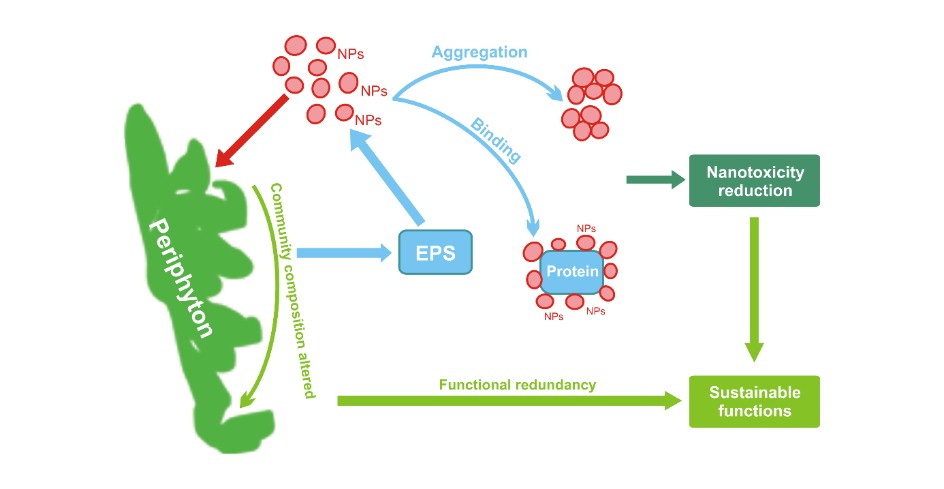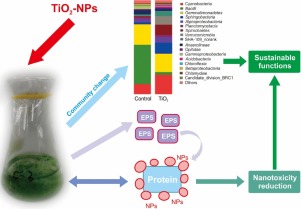在受到外界胁迫时,生态系统的组成及功能会产生多种变化。对于微生物群落而言,组成发生变化而功能维持不变(即功能冗余性)是较为常见的一种现象。自然生物膜是在稻田、沟、塘、浅水湖泊等湿地系统中广泛存在的典型微生物聚集体,具有独特的聚集结构和复杂的群落组成,在湿地生态系统污染物富集、营养盐循环等过程中发挥着不可忽视的作用。人工纳米颗粒越来越多地被使用并释放到环境中,并可对自然生物膜等微生物聚集体产生胁迫作用。研究自然生物膜在纳米颗粒胁迫下群落结构及功能的变化对于深入认识自然生物膜的生态功能及纳米颗粒的环境行为有重要价值。
我室吴永红课题组系统地研究了纳米二氧化钛(TiO2-NPs)胁迫下自然生物膜的响应机制及其污染物去除功能。研究发现,TiO2-NPs胁迫对自然生物膜的光合作用效率及生物量的积累有一定的抑制作用,但是与对照相比并无显著性差异。部分TiO2-NPs可穿透细胞膜,而且在与生物膜接触后,TiO2-NPs的粒径变大,说明发生了聚集作用。TiO2-NPs胁迫下自然生物膜胞外蛋白含量显著增加,而且EPS红外光谱中多个官能团的吸收峰发生偏离,表明EPS在自然生物膜抵抗纳米颗粒胁迫中起着重要作用。此外,TiO2-NPs暴露后自然生物膜维持着较强的COD及Cu去除能力,且与对照组之间无显著差异。说明自然生物膜可通过调整群落结构及代谢等过程来维持原本的污染物去除功能,具有较高的功能冗余性及持续性。
Liu JZ, Tang J, Wan JJ, Wu CX, Bruce Graham, Philip G. Kerr, Wu YH. Functional sustainability of periphytic biofilms in organic matter and Cu 2+ removal during prolonged exposure to TiO 2 nanoparticles. Journal of Hazardous Materials, doi: 10.1016/j.jhazmat.2017.08.068
Abstract
Responses of microbial communities to nanotoxicity in aquatic ecosystems are largely unknown, particularly with respect to relationship between community dynamics and functions. Here, periphytic biofilms were selected as a model of species-rich microbial communities to elucidate their responses when exposed to titanium dioxide nanoparticles (TiO2-NPs). Especially, the relationships between the functions (e.g. organic matter and Cu2+ removal) and community dynamics after long-term exposure to TiO2-NPs were assessed systematically. After 5 days exposure to TiO2-NPs (5 mg L−1), periphytic biofilms showed sustainable functions in pollutant removal and strong plasticity in defensing the toxic disturbance of TiO2-NPs, including photosynthesis and carbon metabolic diversity. The sustainable pollutant removal functions of periphytic biofilms were attributed to their functional redundancy. Specifically, periphytic biofilms altered their composition with cyanobacteria, Sphingobacteriia and Spirochaetes being the newly dominant taxa, and changed the carbon substrate utilization pattern to maintain high photosynthesis and metabolic rates. Moreover, extracellular polymeric substances (EPS) especially proteins were overproduced to bind the NPs and thereby reduce the nanotoxicity. The information obtained in this study may greatly help to understand the interactions between microbial community dynamics and function under NPs exposure conditions and functional redundancy is an important mechanism of periphytic biofilms to maintain sustainable functions.









